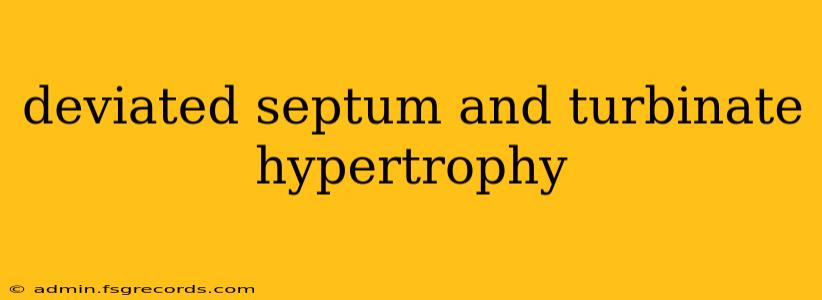A deviated septum and turbinate hypertrophy are common nasal conditions that often occur together, causing significant breathing difficulties. Understanding the intricacies of each condition, how they interact, and the available treatment options is crucial for effective management. This comprehensive guide explores both conditions, their symptoms, diagnosis, and treatment approaches.
What is a Deviated Septum?
The septum is the wall of cartilage and bone that divides your nasal cavity into two halves. A deviated septum occurs when this wall is shifted to one side, narrowing one nasal passage and potentially obstructing airflow. This deviation can be minor or severe, and its cause is often unknown, though it can sometimes result from a nasal injury or birth defect.
Symptoms of a Deviated Septum:
- Nasal obstruction: Difficulty breathing through one or both nostrils, often worse on one side.
- Nasal congestion: A feeling of stuffiness or blockage in the nose.
- Nosebleeds: More frequent or severe nosebleeds.
- Facial pain or pressure: Pain or pressure in the forehead, cheeks, or around the eyes.
- Sinus infections: A deviated septum can contribute to recurrent or chronic sinus infections.
- Sleep apnea: In severe cases, a deviated septum can worsen sleep apnea symptoms.
What is Turbinate Hypertrophy?
The turbinates are bony structures covered with mucous membranes located within the nasal passages. They help to warm, humidify, and filter the air we breathe. Turbinate hypertrophy refers to an enlargement of these turbinates, which can significantly narrow the nasal passages and impede airflow. This can be caused by allergies, nasal polyps, chronic inflammation, or even anatomical variations.
Symptoms of Turbinate Hypertrophy:
Many symptoms overlap with a deviated septum, including:
- Nasal congestion: Persistent stuffiness and blockage in the nose.
- Difficulty breathing through the nose: Making breathing through the nose challenging or impossible.
- Snoring: Enlarged turbinates can contribute to snoring.
- Dry mouth: Due to mouth breathing as a result of nasal obstruction.
- Post-nasal drip: Excess mucus dripping down the back of the throat.
The Interplay of Deviated Septum and Turbinate Hypertrophy
Often, a deviated septum and turbinate hypertrophy co-exist. The septal deviation can further restrict airflow, exacerbating the effects of enlarged turbinates. This combination can lead to more severe nasal obstruction and a greater impact on overall breathing and quality of life. The enlarged turbinates might also be a compensatory mechanism for a deviated septum, attempting to maintain adequate airflow.
Diagnosis of Deviated Septum and Turbinate Hypertrophy
Diagnosis typically involves a physical examination of the nose using a nasal speculum. The doctor will visually assess the septum and turbinates to determine the extent of the deviation and hypertrophy. In some cases, imaging techniques such as a CT scan might be used to provide a more detailed view of the nasal structures.
Treatment Options for Deviated Septum and Turbinate Hypertrophy
Treatment options depend on the severity of the symptoms and the individual's overall health.
Septoplasty:
Surgical correction of a deviated septum. This procedure straightens the septum, improving nasal airflow.
Turbinate Reduction:
Several procedures can reduce the size of enlarged turbinates, including:
- Radiofrequency ablation: Uses radiofrequency energy to shrink the turbinates.
- Submucous resection: Surgical removal of a portion of the turbinate.
- Laser turbinoplasty: Uses a laser to reduce the size of the turbinates.
- Cryosurgery: Uses extreme cold to destroy excess turbinate tissue.
Medical Management:
In some cases, medical management might be sufficient to alleviate symptoms, especially if the condition is mild. This could include nasal corticosteroids (sprays) to reduce inflammation or saline nasal sprays to help moisturize and clear nasal passages.
Choosing the Right Treatment
The best treatment approach will be determined by a healthcare professional based on a thorough evaluation of the individual's specific condition, symptoms, and overall health. It's crucial to consult an ENT specialist (otorhinolaryngologist) for an accurate diagnosis and personalized treatment plan. They can discuss the risks and benefits of each procedure and help you make an informed decision. While surgery is often effective, it's essential to understand the potential risks and recovery time involved.
This information is for educational purposes only and should not be considered medical advice. Always consult with a qualified healthcare professional before making any decisions related to your health or treatment.

